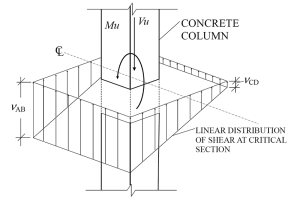It is a well-understood concept and an inevitable law of statics that loads must be transferred between beams and columns. This is an idea that is not foreign to engineers. Since our first classes in structural analysis, we have been developing our expertise at analyzing and designing beam-column intersections. The idea of balancing the sum of forces at such locations is one that cannot be disputed. However, there are some vagaries with this concept when considering flat plate and flat slab systems, which by definition have no beam-column joints. Hence, moment transfer becomes a more complex issue.
Some engineers choose to ignore it, and they may even be rationally justified in doing so. This certainly simplifies the analysis, requiring only a two-way punching shear calculation. When does an engineer need to consider the transfer of moments between flat plates/slabs and columns? This is a difficult question, one for which the past several versions of ACI 318 – including ACI 318-14 – do not provide a direct answer.
Section 8.4.2.3.1 states: “If gravity load, wind, earthquake, or other effects cause a transfer of moment between the slab and column, a fraction of Msc, the factored slab moment resisted by the column at a joint, shall be transferred by flexure in accordance with 8.4.2.3.2 through 8.4.2.3.5.” Later on, section 8.4.3.2.6 states: “The fraction of Msc not calculated to be resisted by flexure shall be assumed to be resisted by eccentricity of shear in accordance with 8.4.4.2.”
Sections 8.4.2.3.2 through 8.4.2.3.5 address the development and proportioning of the Msc force as applied flexural and shear forces originating from the factored slab moment. The distribution of shear stress at the critical perimeter might then follow a pattern as depicted in Figure 1.
A valid question at this point might be when transfer of moments does not occur. Of course, there is no such thing as a perfectly balanced load; eccentricities and similar phenomena are always present. Moments will never perfectly balance from one side of a column to another, regardless of the precise geometries. Codes even prescribe such things as ‘accidental’ eccentricity that must be included in design due to unbalanced moments that cannot be explicitly accounted for.
The language in codes (and concrete textbooks) seems to indicate that there is a point at which flexural and shear loads due to transfer moments from slabs to columns must be considered. However, no reference clearly indicates what that point is. To be conservative, we could always account for it. There is nothing wrong with this, except for the extra time that it requires in an often lean atmosphere of budgets and schedules. Leading researchers have stated that this transfer of moments should be considered whenever it becomes significant to the analysis – just a more complex and equally vague reiteration of what ACI 318 already states! Others have indicated that at an unbalanced column moment in excess of 10% from one side of the slab to the other is an appropriate trigger for requiring this level of analysis.
As ACI 318 is currently written, it is contingent upon us as design engineers to exercise appropriate judgment in determining whether the transfer of moments between the slab and the column is significant. In some cases, such as edge/corner columns or slabs with inconsistent bay sizes, there will clearly be a greater likelihood for significant transfer moments at this interface. For interior columns with consistent bay spacing, continuity of the slab and compatible stiffnesses between adjacent bays may predicate a transfer of flexure small enough to be ignored. This may be true especially for concrete shear wall structures or projects in regions of lower seismicity (Seismic Design Category A, B, or C), where the effects of deformation compatibility issues per ASCE 7-10 section 12.12.5 are not significant. However, we must make such a determination on a case-by-case basis.▪
A similar article was published in the Structural Engineers Association-Utah (SEAU) Monthly Newsletter (January 2012). Content is reprinted with permission.

